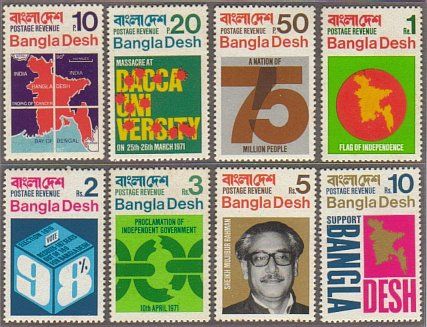Stamped in time: Tracing Bangladesh’s journey through decades of postal history
Stamped in time: Tracing Bangladesh’s journey through decades of postal history

9th October marks World Post Day, a day to celebrate the postal service and its role in connecting people, communities, and nations. One interesting aspect of the letters and parcels sent through this service is the tiny stamp, which carries stories of our past, our struggles, and our dreams, sending messages far beyond its size.
On this Post Day, let us look at some of Bangladesh’s stamps through the decades to see how our history has been shaped and who we are as a nation.
1970s: Emergence of a young nation
In the 1970s, Bangladesh’s stamps reflected the country’s early celebration, struggle and identity. In 1971, soon after independence, Biman Mallik designed the first eight stamps, showcasing key moments such as the Dhaka University massacre on March 25, the broken chain representing the proclamation of independence, the ballot box for democracy, the map of the new nation, and the national flag — symbolising the hopes of 75 million people. By 1975, the focus turned to cultural life, with stamps featuring farming, fishing, pottery, and crafts that represented everyday Bangladeshi life. However, in 1977, remnants of colonial influence still appeared when stamps marked Queen Elizabeth II’s Silver Jubilee, reminding us how traces of the past still lingered in the imagery of a young nation.


1980s: Recognition, progress, and global links
In 1982, stamps honoured the seven Bir Sreshtha, celebrating the heroes of the Liberation War. In 1985, the UN Decade for Women was marked with images of women as teachers, scientists, and weavers, highlighting empowerment and equality. The same year also celebrated the first SAARC Summit in Dhaka with stamps of the member countries’ flags and symbolic birds. In 1987, a stamp featuring President Hussain Muhammad Ershad marked the first anniversary of the institutionalisation of democracy, reflecting the political mood of the time. In 1989, Bangladesh joined global celebrations of the 200th anniversary of the French Revolution and inaugurated the Bangladesh Security Printing Press, showing both global awareness and national progress.


1990s: Milestones reflected on stamps
In the 1990s, Bangladesh’s stamps highlighted key national milestones and political transformations. In 1991, alongside the 20th anniversary of independence, stamps marked the 10th death anniversary of President Ziaur Rahman, reflecting that the Bangladesh Nationalist Party (BNP) was in power. In 1993, stamps celebrated the 1,400th anniversary of the Bengali calendar, emphasising cultural heritage. Development achievements were also commemorated, including the Dhaka International Trade Fair in 1995 and the inauguration of the Jamuna (Bangabandhu) Bridge in 1998, as the political power shifted to Bangladesh Awami League. In 1999, Bangladesh’s first appearance in the ICC Cricket World Cup was featured, representing growing national pride and international presence.


2000s: Heritage and national achievements
The 2000s focused on cultural pride and notable achievements. In 2002, a golden stamp marked the 50th anniversary of the Language Movement. In 2003, Ziaur Rahman’s death anniversary stamp returned after the BNP came to power, alongside an “Eid Mubarak” issue. In 2004, the opening of the Bhashani Novo Theatre (now known as Novo Theatre) was celebrated. In 2007, stamps highlighted women’s empowerment through standing up against the dowry issue and proudly celebrated Bangladesh’s first-ever Nobel Peace Prize earned by Dr. Muhammad Yunus in 2006 . By 2008, the 400th anniversary of capital Dhaka and Cox’s Bazar’s recognition as the world’s longest sea beach captured the nation’s evolving identity and achievements.



2010s: Remembrance and technological development
In the 2010s, Bangladesh’s stamps reflected both national heritage and modernisation. In 2010, a stamp marked the inauguration of the International Mother Language Institute, emphasising the country’s respect for linguistic heritage. Highlighting service and cultural preservation. centenaries of key institutions followed, including the Bangladesh Police Academy in 2012 and the National Museum in 2013. In 2016, a commemorative stamp depicted the family members of Sheikh Hasina who were killed in the August 15 tragedy, linking remembrance with political legacy. The later years focused on technological progress and national power, with the Rooppur Nuclear Power Plant in 2017, the country’s first nuclear facility, and Bangladesh’s first satellite, Bangabandhu-1, in 2018, marking significant advances in energy and space.


2020s: Digital progress, infrastructure, and a turn toward a new identity
In the 2020s, Bangladesh’s stamps reflected political commemoration, national achievements, and generational change. 2020 marked the birth centenary of Sheikh Mujibur Rahman; most of the stamps focused on Bangabandhu and Sheikh Hasina, continuing a trend from the previous decade. Other than that, in 2021, stamps celebrated the 100th anniversary of Dhaka University, honoured the war heroines titled Biranganas, and highlighted Digital Bangladesh Day along with the launch of 5G services, emphasising the country’s technological progress. The following years featured major infrastructural milestones, including the 50th anniversary of Biman Bangladesh Airlines, the opening of the Padma Bridge, and the Dhaka Metro Rail system. In 2023, national pride centered on the SAFF Women’s Championship victory and the opening of the Bangabandhu Sheikh Mujibur Rahman Tunnel. The political trend shifted as the autocratic regime of the former government was overthrown, and student-led revolution created a new sense of identity and hope. Following this, stamps began celebrating youth and collective optimism, such as the “Festival of Youth” in 2024, continuing in 2025 with issues commemorating the July Uprising, reflecting the country’s renewed spirit and generational voice.


Certainly, each stamp tells a story, capturing moments through the decades that words alone cannot. They remind us that history, culture, and hope can live in the smallest of spaces, and that through remembering, we keep the spirit of our nation alive.


